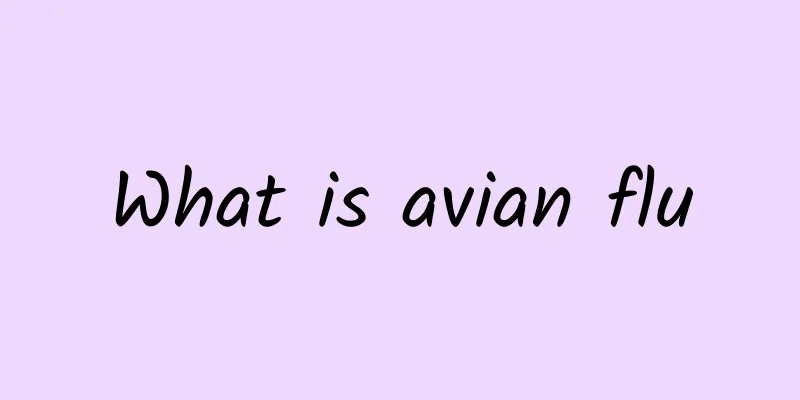What is avian flu

|
Many friends usually only have a vague understanding of what avian influenza is. Avian influenza is a human disease mainly caused by viral infection. Generally speaking, it has three levels: high, medium and low. In addition, although its clinical manifestations are similar to those of colds and fevers, its harm is more serious than colds and fevers. So how should avian flu be treated? In fact, avian influenza is one of the more prevalent diseases in spring and summer, and its incubation period is relatively long. In addition to symptoms such as fever and cough, there may even be symptoms such as difficulty breathing. If not treated in time, it can easily lead to hypoxia and failure of various organs in the human body. Below is a detailed introduction to what avian influenza is. What is avian flu Avian influenza infection is a human disease caused by the avian influenza virus. Avian influenza virus belongs to type A influenza virus. According to the different pathogenicity of avian influenza virus to chickens and turkeys, it is divided into three levels: high, medium, and low/non-pathogenic. Due to the characteristics of the hemagglutinin structure of the avian influenza virus, it generally infects poultry. When the virus undergoes genetic recombination during the replication process, causing the structure to change and gaining the ability to infect humans, it may cause human infection with avian influenza. Clinical manifestations According to the investigation results of existing human infection cases of H7N9 and H5N1 avian influenza, the incubation period is generally within 7 days. In the early stages of the disease, patients experience flu-like symptoms, including fever and cough, which may be accompanied by headache, muscle aches, and general discomfort. They may also experience runny nose, nasal congestion, sore throat, etc. Some patients experience symptoms such as chest tightness and difficulty breathing when their lung lesions are severe or their condition progresses rapidly. Respiratory symptoms appear early, usually within one week after onset, and last for a long time. Some patients still have severe cough and sputum one month after treatment. In the early stages of the disease, there are chest tightness, shortness of breath and difficulty breathing, which often indicates that the lung lesions are progressing rapidly and will quickly develop into severe hypoxia and respiratory failure. treat The treatment strategy for humans infected with avian influenza is mainly to provide symptomatic maintenance, anti-infection, ensure tissue oxygen supply, and maintain organ function under appropriate isolation conditions. Symptomatic maintenance mainly includes bed rest, dynamic monitoring of vital signs, and physical or drug cooling. Anti-infection treatment includes antiviral (such as oseltamivir, zanamivir, peramivir, etc.) and anti-bacterial, anti-viral and anti-fungal, but emphasizes that the timing of clinical treatment should be "early, fast and accurate". In particular, respiratory specimens should be collected before using antiviral drugs, and they should be used within 48 hours of onset as much as possible. For cases where antiviral drugs are clinically considered to be necessary, they can also be used after more than 48 hours of onset. Ensuring tissue oxygenation is the key to maintaining the normal function of vital organs in critically ill and severe patients, which can be achieved through a sequential selection of nasal tubes, oral/nasal masks, non-invasive ventilation and invasive ventilation. Regarding what avian influenza is, in fact, avian influenza is a viral disease caused by long-term contact with sick poultry, such as sick chickens, sick geese, etc. Although the early symptoms of the disease are not obvious, timely medical treatment and treatment in the early stages of the disease can help alleviate the occurrence of various symptoms and even speed up the recovery of the disease. Therefore, if you have symptoms suspected of a cold, you should seek medical attention and treatment in a timely manner. |
<<: First aid for cerebral hemorrhage
Recommend
Side Effects of Rhubarb
In fact, rhubarb is a Chinese herbal medicine tha...
I got pregnant just after my period stopped.
I believe many people have heard that the probabi...
The efficacy of drinking tangerine peel and chrysanthemum in water
Tangerine peel and chrysanthemum are both traditi...
What are the medicinal values of saffron?
Saffron is distributed all over the world, for ex...
Can mild cervical spondylosis heal itself?
The incidence of cervical spondylosis is relative...
Stick to one bathing method and all diseases will disappear
Taking a bath may seem like a simple question, bu...
Can I have an abortion if I have gynecological disease?
Pregnant women with gynecological diseases cannot...
What causes trembling lips? Beware of facial spasm
Lip trembling, or lip twitching, is often caused ...
The best way to treat baby's red buttocks
In daily life, if the mother does not take good c...
What are the symptoms of yin and yang deficiency and insufficient qi and blood?
Deficiency of both Yin and Yang and insufficient ...
What should I do if the chili pepper chokes my trachea?
Chili is a condiment loved by many people. The sp...
What to do if your skin is red and itchy? An old Chinese doctor tells you a folk remedy
Sometimes, people may experience redness and itch...
Central nervous system
Our computer has a central processing unit, which...
How many months should pregnant women take folic acid tablets
We all know that women prefer to eat acidic foods...
Can I apply ice after wisdom tooth extraction?
The quality of teeth affects human health. Good t...









